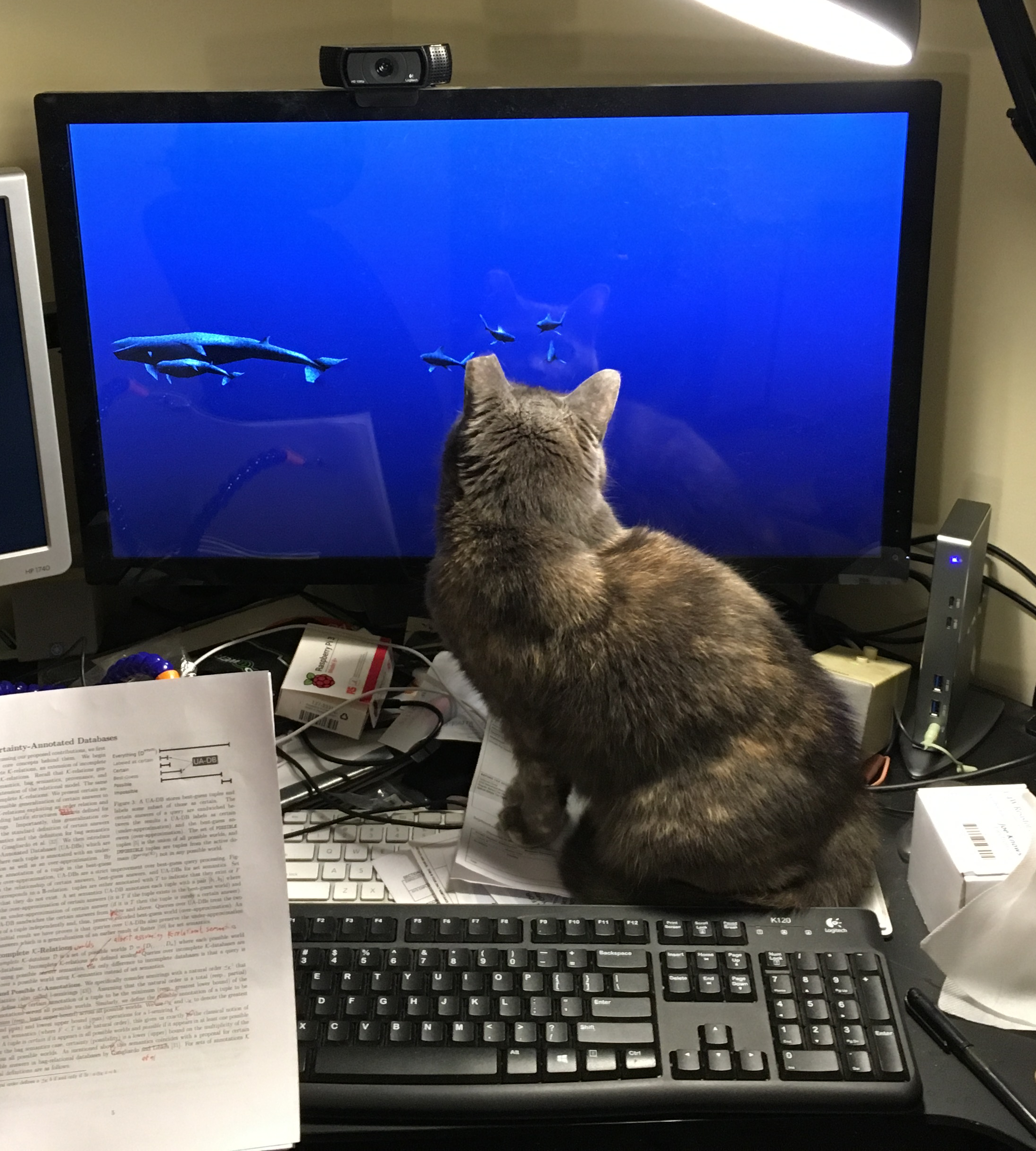Function Analysis
CSE-250 Fall 2022 - Section B
Sept 7, 2022
Textbook: Ch. 7.3-7.4
Announcements
- AI Assignment Due TONIGHT.
- PA 0 due Friday Night (68%/90% progress towards early PA1 submissions).
- Office Hour locations posted.
What is "Fast"?
When is an algorithm "fast"?
- Real world ("Wall Clock") time?
- Is 10s fast? 100ms? 10μs?
- It depends on the task!
- Do you rank the algorithm or the implementation?
- Compare Grace Hopper's implementation to yours.
- CPU Effects (e.g., ARM RK3399S vs Intel i9 vs AMD 5950)
- Different speed/capability trade-offs
- Bottlenecks: CPU vs IO vs Memory vs Network vs ...
Wall-clock time is not great for a 50k-ft view.
(a) and (b) are more "the same" than either is to (c)
When is an algorithm "fast"?
- Look at relative performance.
- How does performance change relative to...
- ... the number of input records
- ... the number of users in the system
- ... the number of pixels to be displayed
- ... the size of the neural network
Idea: Classify runtimes by the "shape" of their scaling curve.
Scaling
- "Five steps plus ten steps per user"
- $5 + 10 \times |\texttt{Users}|$
- "Ten steps per connection; Each user has connections to 1% of the other users"
- $10 \times ( |\texttt{Users}| \times (0.01 \times |\texttt{Users}|)) $
- "Seven steps for every possible combination of users"
- $7 \times (2^{|\texttt{Users}|})$
- "For each user: ten steps plus three per post"
- $|\texttt{Users}| \times (10 + 3 \times |\texttt{Posts}|)$
When is an algorithm "fast"?
- Focus on how the algorithm scales.
- Look at the number of steps as a function of "input size".
Which is better $3|\texttt{Users}|+5$ or $|\texttt{Users}|^2$?
When is an algorithm "fast"?
- Focus on how the algorithm scales.
- Look at the number of steps as a function of "input size".
- Focus on "large" inputs.
- Look at the number of steps on large input sizes.
What hardware are you using?
 Intel i9 |
vs |  Motorola 68000 |
Who implemented the algorithm?
 Epic-Level Implementation |
vs |  Error 23: Cat on Keyboard |
Goal: Judge Algorithms, Not Implementations
- How fast is a step?
- Don't care, only count number of steps
- Can we cut out steps?
- Don't care...
When is an algorithm "fast"?
- Focus on how the algorithm scales.
- Look at the number of steps as a function of "input size".
- Focus on "large" inputs.
- Look at the number of steps on large input sizes.
- Focus on high-level ideas, not implementation.
- ???
... a brief digression ...
Logarithms
(Refresher)
Logarithms (Refresher)
- Let $a, b, c, n > 0$
- Exponent Rule: $\log(n^a) = a \log(n)$
- Product Rule: $\log(an) = \log(a) + \log(n)$
- Division Rule: $\log\left(\frac{n}{a}\right) = \log(n) - \log(a)$
- Change of Base from $b$ to $c$: $\log_b(n) = \frac{\log_c(n)}{\log_c(b)}$
- Log/Exponent are Inverses: $b^{\log_b(n)} = \log_b(b^n) = n$
Logarithms (Refresher)
In this class, assume base-$2$ logarithms by default.
Question: How do we talk about runtime?
Attempt 1: Growth Functions
$$f(n)$$- $n$: The "size" of the input
- e.g., the number of users, rows of data, etc...
- $f(n)$: The number of "steps" taken for an input of size $n$
- e.g., 20 steps per user is $20\times n$ (with $n = |\texttt{Users}|$)
Side Note: A growth function is not code; it's an algebraic function.
Attempt 1: Growth Functions
Assumptions about $f(n)$
- Problem sizes are non-negative integers
- $n \in \mathbb Z^+ \cup \{0\}$
- We can't reverse time
- $f(n) \geq 0$
- Smaller problems aren't harder than bigger problems
- For any $n_1 < n_2$, $f(n_1) \leq f(n_2)$
To make the math simpler, we'll allow fractional steps.
Attempt 1: Growth Functions
$$f : \mathbb Z^+ \cup \{0\} \rightarrow \mathbb R^+$$Problem: We're still implementation dependent...
$$f_1(n) = 20n$$ $$f_2(n) = 19n$$$f_1$ and $f_2$ are more "the same" than either is to $f_3$
Behavior At Scale
Compare the following two functions: $$f_1(n) = \frac{1}{100}n^3 + 10n + 1000000\log(n)$$ $$f_2(n) = n^3$$Behavior At Scale
After ~1024, both lines stay ~100x apart.
$f_1$ and $f_2$ "behave" the same.
Behavior At Scale
Attempt 2: Asymptotic Analysis
Asymptotic Analysis @ 5000 feet
Consider $f(x)$ vs $g(x)$
Case 1:
$lim_{n\rightarrow \infty}\frac{f(n)}{g(n)} = \infty$
($f(n)$ gets bigger w.r.t. $n$)
If $f(n)$, $g(n)$ are the number of steps an algorithm takes on an input of size $n$, which is better?
Asymptotic Analysis @ 5000 feet
Case 1:
$lim_{n\rightarrow \infty}\frac{f(n)}{g(n)} = \infty$
($f(n)$ is "bigger"; $g(n)$ is the better runtime on larger data)
Case 2:
$lim_{n\rightarrow \infty}\frac{f(n)}{g(n)} = 0$
($g(n)$ is "bigger"; $f(n)$ is the better runtime on larger data)
Case 3:
$lim_{n\rightarrow \infty}\frac{f(n)}{g(n)} = \text{some constant}$
($f(n)$, $g(n)$ "behave the same" on larger data)
Asymptotic Analysis @ 5000 feet
Goal: Organize runtimes (growth functions) into different Complexity Classes.
Within a complexity class, runtimes "behave the same"
Asymptotic Analysis @ 5000 feet
"Strategic Optimization" focuses on improving the complexity class of code.
Asymptotic Analysis @ 5000 feet
$$f_1(n) = \frac{1}{100}n^3 + 10n + 1000000\log(n)$$ $$f_2(n) = n^3$$
The $10n$ and $1000000\log(n)$ "don't matter"
The $\frac{1}{100}$ "doesn't matter"
The $n^3$ "dominates" both growth functions for large $n$.
Asymptotic Analysis @ 5000 feet
$5\cdot 2^n + n^{1000} + 2^{\log(n)}$
Why focus on dominating terms?
| $f(n)$ | 10 | 20 | 50 | 100 | 1000 |
|---|---|---|---|---|---|
| $\log(\log(n))$ | 0.43 ns | 0.52 ns | 0.62 ns | 0.68 ns | 0.82 ns |
| $\log(n)$ | 0.83 ns | 1.01 ns | 1.41 ns | 1.66 ns | 2.49 ns |
| $n$ | 2.5 ns | 5 ns | 12.5 ns | 25 ns | 0.25 µs |
| $n\log(n)$ | 8.3 ns | 22 ns | 71 ns | 0.17 µs | 2.49 µs |
| $n^2$ | 25 ns | 0.1 µs | 0.63 µs | 2.5 µs | 0.25 ms |
| $n^5$ | 25 µs | 0.8 ms | 78 ms | 2.5 s | 2.9 days |
| $2^n$ | 0.25 µs | 0.26 ms | 3.26 days | 1013 years | 10284 years |
| $n!$ | 0.91 ms | 19 years | 1047 years | 10141 years | 🤯 |
Next time on CSE-250
Asymptotic notation: This time it's formal